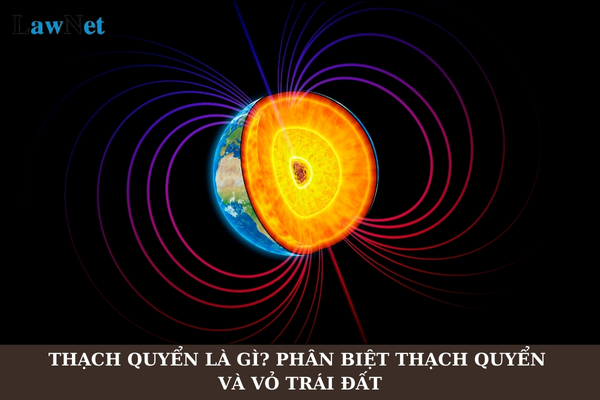Vietnam: What is the Lithosphere? What are the guidelines for distinguishing the Lithosphere from the Earth's Crust? What is the grade at which students will learn about Lithosphere?
What is the Lithosphere? What are the guidelines for distinguishing the Lithosphere from the Earth's Crust?
*What is the Lithosphere?
The lithosphere is the outermost rigid and solid layer of the Earth, which includes the entire Earth's crust and the uppermost part of the mantle.
This is where many important geological phenomena take place, such as earthquakes, volcanoes, and the movement of tectonic plates. The lithosphere has an average thickness of about 100 km, but it can vary depending on the region, being thinner under oceans and thicker under continents.
*What are the guidelines for distinguishing the Lithosphere from the Earth's Crust?
The differences between the lithosphere and the Earth's crust are as follows:
- The Earth's crust is the outermost layer, primarily composed of layers of hard rock, with thickness ranging from 5 - 70km, divided into continental crust and oceanic crust. The Earth's crust consists of sedimentary rock layers, granite layers, and basalt layers.
- The lithosphere includes both the Earth's crust and a thin, rigid part of the upper mantle, with a thickness of about 100km. The lower boundary contacts the asthenosphere, which has a ductile characteristic.
Below is a comparative table to distinguish these two concepts:
| Criteria | Lithosphere | Earth's Crust |
| Definition | The outermost solid layer of the Earth, including both the Earth's crust and the upper mantle. | The outermost layer of Earth, composed of solid rock. |
| Scope | Encompasses the entire Earth's crust and part of the upper mantle. | Just the outermost part of Earth. |
| Thickness | Average 100 km. | Average 35-40 km, even up to 70 km (continental) or 5-7 km (oceanic). |
| Mechanical properties | Rigid, strong, and moving as tectonic plates. | Not directly involved in tectonic plate motion. |
| Role | Location of geological activities like earthquakes, and volcanoes. | Only part of what makes up the lithosphere. |
Note: The concept of the lithosphere and the guidelines for distinguishing the Lithosphere from the Earth's Crust are for reference only.

What is the Lithosphere? What are the guidelines for distinguishing the Lithosphere from the Earth's Crust? What is the grade at which students will learn about Lithosphere? (Image from the Internet)
What is the grade at which students in Vietnam will learn about Lithosphere?
Under Section V of the General Education Program in Geography issued with Circular 32/2018/TT-BGDDT, learning outcomes required for Natural Geography in the 10th-grade Geography curriculum are as follows:
- Present the origin of Earth's formation, the characteristics of the Earth's crust, and the materials composing the Earth's crust.
- Summarize the plate tectonics theory; use it to explain the formation causes of young mountain ranges, earthquakes, and volcanic belts.
- Analyze the geographical consequences of Earth's main movements: axial rotation (day-night alternation, time on Earth); revolution around the Sun (seasons in a year, day and night length variations according to latitude).
- Relate local reality to seasons and day-night time differences.
- Use drawings, and maps to analyze the consequences of Earth's movements.
- Present the concept of the lithosphere; distinguish the lithosphere from the Earth's crust.
- Present the concepts of internal and external forces; their causes; impacts on Earth's surface terrain formation.
- Analyze diagrams, maps, images about the impact of internal and external forces on Earth's surface terrain.
- Comment and explain the distribution of earthquake and volcanic belts on maps.
Thus, the concept of the lithosphere and the guidelines for distinguishing the Lithosphere from the Earth's Crust are taught in the 10th-grade Geography curriculum.
What are the orientations to the methods for forming and developing geographical competencies in Vietnam?
Under Section VI of the General Education Program in Geography issued with Circular 32/2018/TT-BGDDT, the orientations to the methods for forming and developing geographical competencies in Vietnam are as follows:
- To develop the component of geographical scientific cognitive competencies, teachers need to:
+ To provide students with opportunities to leverage existing knowledge and experience to participate in forming new knowledge.
+ To pay attention to organizing activities that approach geographical objects and phenomena occurring in life according to the spatial-temporal relationship, answering basic questions: what, where, how...;
+ To train students in skills to analyze interactive and causal relationships between natural geographical phenomena and processes and between natural and socio-economic systems.
- To develop the component of geographical inquiry competencies, teachers should enable students to use geography tools like geographical atlases, maps, diagrams, charts, sections, models, blocks, data tables, and images, ... to explore geographical knowledge; enhance the use of Ithe nternet in learning, organize field trips, in natural, socio-economic settings.
- To develop the component of applied geographic knowledge and skills competencies, students need:
+ To be provided with opportunities to update information and connect with reality, approach practical situations, and engage in discovery-based learning activities from practice;
+ To apply geographic knowledge and skills to solve some practical problems appropriately.
- Additionally, teachers should focus on training students in skills of problem detection, planning research, solving problems, evaluating results, presenting remedial or improvement measures, and enhancing exercises requiring practical knowledge application and critical, creative thinking.

